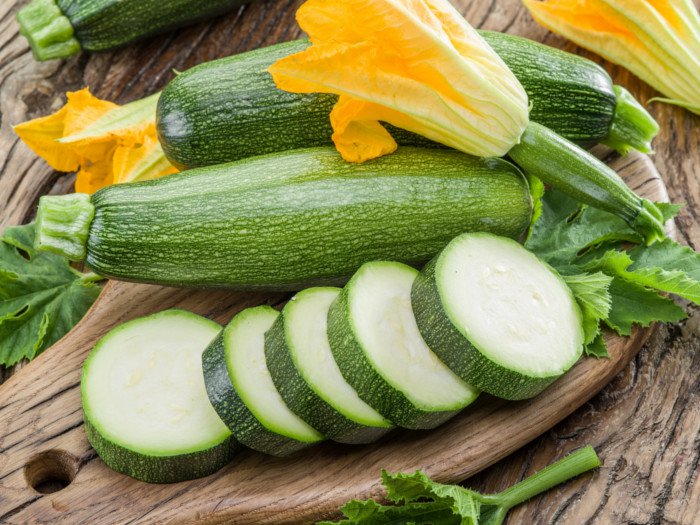
Zucchini Season
 Pick zucchinis at 6-8 inches to stay ahead of the harvest.
Pick zucchinis at 6-8 inches to stay ahead of the harvest.
By Thomas Christopher
I remember my first vegetable garden, dug when I was 16 years old. I went away for several weeks that summer, entrusting the care of my patch to my sister. When I returned I found that she had decided the steadily inflating, huge green fruits must be watermelons. They were, of course, zucchinis, and grossly inedible by the time I cut them from the vines.
This recollection can still make my sister laugh. In fact, there is something intrinsically comical about zucchinis. I suppose it’s their Freudian aspect, that and their outrageous fecundity. In fact, just a couple of plants will flood the garden with summer squash faster than the average family can eat them all. Giving away zucchini at the height of their harvest season isn’t easy, either, and exposes the gardener to endless witticisms. Yet, really, shouldn’t their irrepressible fruitfulness make zucchinis a vegetable garden hero rather than the butt of snide jokes?
A zucchini plant doesn’t ask for much: a scrap of fertile, well-watered soil in a sunny spot is enough. The only major pest is the squash vine borer, a moth that lays its eggs at the base of the squash vines. The eggs hatch into grub-like larvae that bore into the squash stems, causing them to wilt and then die. Fortunately, the remedy is easy. When the wild chicory starts to open its blue, roadside flowers, (usually around mid-June) cover the squash plants with a floating row cover to bar the moths’ access. Bury the edges of the row cover to keep the moths from crawling under it and keep it in place for 3 weeks. It’s important to remove the row covers as the squash vines come into full flower as they (the row covers) also keep pollinators from reach the blossoms and so prevent fruiting.
Zucchinis have a delicate flavor and I’ve found that in some cultivars of the plant the flavor can veer into blandness. I’ve come to favor an old Italian cultivar, ‘Costato Romanesco,’ an enthusiastic producer of ridged fruits with a nutty taste and firm, less watery texture.
My wife and I try to keep ahead of the zucchini harvest by picking the fruits when they are still small and tender, 6-8 inches long. Another approach to zucchini control, of course, is to harvest the blossoms. My father, who spent several years in Italy as a foreign correspondent in the 1950’s, always recalled fondly the fried zucchini flowers that were a specialty of Roman restaurants. I intend to try that this summer, dipping them in a beer and flour batter and then frying them briefly in hot vegetable oil. Served salted and still hot, they should make a perfect complement for some crisp, chilled Italian white wine, maybe a Frascati from the region around Rome.
Of course, some zucchini squashes always manage to hide away in the plants’ thick foliage, growing too big for the saucepan. These can be stuffed. I ordinarily split them and scoop out the seedy interior, which I mix with garlic, bread crumbs, parmesan cheese and the pork sausage I get from a nearby farm in the Berkshires. I refill the zucchinis with this blend and drench with homemade tomato sauce. Then I cover them with foil and bake in a 350°F. oven until the sausage meat is cooked.
That’s a tried and true recipe, but I’m longing to try one from an antique Italian cookbook, Science in Cooking and the Art of Eating Well by Pellegrino Artusi (translated as Italianissimo: Italian Cooking at Its Best by Elisabeth Abbott). This calls for stuffing the zucchini with chopped tuna fish in oil mixed with egg, a pinch of parmesan, some of what you removed from the zucchini, spices (unspecified – I’m going to try basil) and pepper. Cook the stuffed zucchini in butter until golden brown and then anoint them with tomato sauce. The result, promised Artusi, “will be so good you will hardly believe your luck.”
That, at least, is no laughing matter.
Thomas Christopher is the co-author of “Garden Revolution” (Timber Press, 2016) and is a volunteer at Berkshire Botanical Garden. berkshirebotanical.org
Be-a-Better-Gardener is a community service of Berkshire Botanical Garden, one of the nation’s oldest botanical gardens in Stockbridge, MA. Its mission to provide knowledge of gardening and the environment through 25 display gardens and a diverse range of classes informs and inspires thousands of students and visitors on horticultural topics every year. Thomas Christopher is the co-author of Garden Revolution (Timber press, 2016) and is a volunteer at Berkshire Botanical Garden. berkshirebotanical.org.


